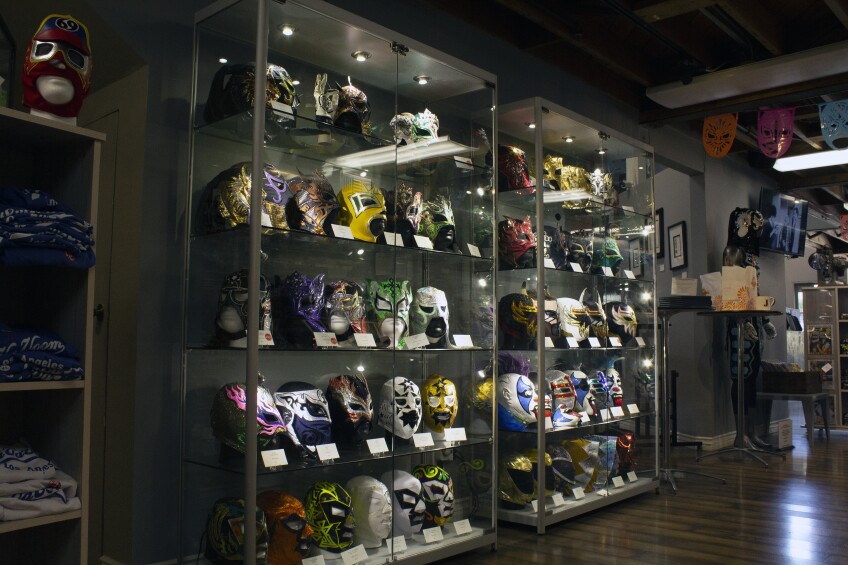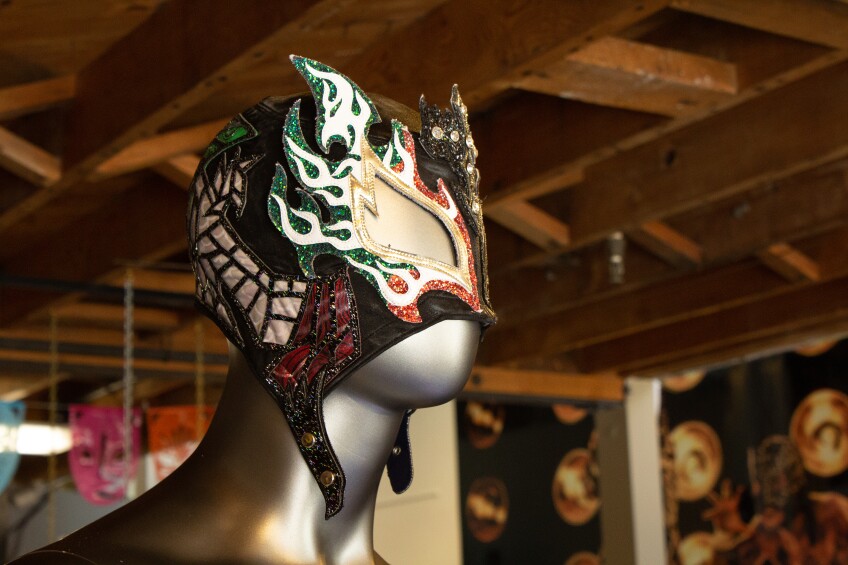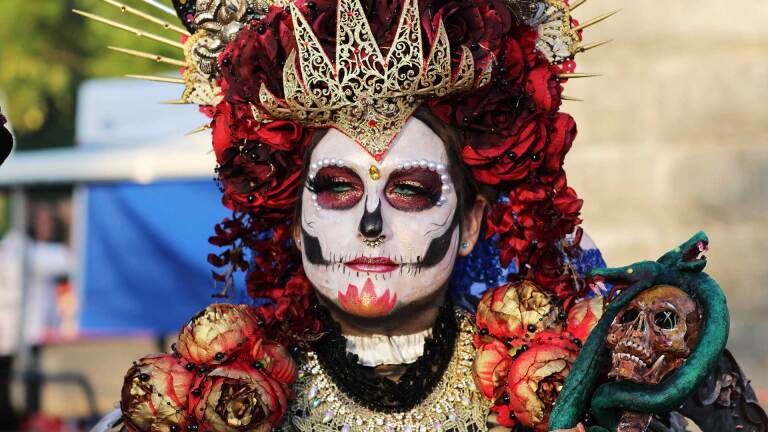Republic of Lucha Provides a Haven for Lucha Libre Culture in L.A.

The first thing one sees when walking by the Republic of Lucha's storefront in South Pasadena are two mannequins posed inside a small, makeshift wrestling ring. They're dressed in the full ring attires of lucha libre wrestlers Rey Fenix and Penta Cero M. The outfits, consisting of Penta's black-and-red boots, pants, mesh tank top and mask with neck drape and Fenix's boots, tights and mask decked in black with flames in vibrant green, white, red and gold flames and webs, repeatedly catch the eyes of many pedestrians, such as a man who showed more childlike enthusiasm than his own son on the Saturday afternoon of my visit to the space.
"Dad, what is this?" asked the boy, probably about eight or nine years old, as they peeked inside the door to admire the masked mannequins. Despite being indoors, the mannequins stood out among the other two-tone colored storefronts on Mission Street near the South Pasadena Metro L Line station.
"This," answered his father, grinning from ear to ear, "is AWESOME!"

Republic of Lucha, besides being awesome, is a space dedicated to the world of lucha libre, the freestyle form of wrestling made famous in Mexico. Wrestling isn't unique to Mexico as the popularity of World Wrestling Entertainment in the US and the many wrestling federations and wrestlers in Japan can attest to. Lucha libre, however, is distinct in its aesthetics, its appeal and its style thanks to the acrobatic, high-flying expertise of many of its masked and elaborately costumed practitioners.
Javier Robles planted the initial seed for the idea and concept that became Republic of Lucha. He's worked with Lucha Va Voom, an annual event in Los Angeles that combines lucha libre, live music, burlesque and comedy and with other lucha libre promoters for many years. He also works in artist management via his company Mayor Arce.
"We got together and talked about creating something new," explains Robles, who co-owns the space with Fenix, Penta and Ari de Alba. "Historically, masked wrestlers don't have a reputation for being careful with their money, of investing their money, of planning their futures and this new generation of wrestlers, not all but many, I believe, have more of a mentality as business managers. It's not just about buying cars or luxuries or simply doing something extra for their careers or their brand."
The group decided to open a space in Los Angeles to celebrate lucha libre culture because it's the strongest market for lucha libre. Their opening day four months ago proved as much as 400 people stood in line beginning at their door that wrapped around the block. The irony of socially distanced attendees in face masks waiting to enter a store dedicated to masked wrestlers wasn't lost on anyone. They've since received offers to open satellite stores in Houston and Chicago.
"We're in Los Angeles where 51% of the population is Latino and 70% of that is Mexican," adds Sergio Arau, a multidisciplinary artist whose series of lucha libre-inspired artwork is currently on display as the "A Tres Caídas" exhibit at Republic of Lucha. The exhibit features paintings of masked men and women in various settings and poses similar to those found in traditional portraits of angelic/religious figures and portraits of indigenous people ubiquitous in many Mexican homes.

One small portrait is dedicated to El Santo, undoubtedly the most famous masked wrestler of them all. The portrait isn't the first time Arau has immortalized the silver-masked hero of lucha libre who rose to the status of folk hero and legend in Mexico. Arau and his band, Botellita De Jerez, wrote a song dedicated to El Santo after his death in 1984 titled "El Guacarock Del Santo" with lyrics that place Santo's heroic exploits on a level above Batman and Superman.
"Lucha libre is something very dear and personal to all Mexicans," continues Arau. "All of my work, be it music, animation, film or art, is about popular Mexican culture and lucha libre is one of the most visible things there is. Compare that with the culture here, the gringo culture, where a mask is usually something associated with terrorism, with sadomasochism. There's no tradition behind it whereas in all of Mexico, the Indigenous communities use masks, all of the fiestas in every state utilize masks, there are museums dedicated to masks made of different materials. For us, masks are something very natural."
The space features a store that sells custom lucha libre merchandise including apparel such as shirts, hats and leggings printed in-house at the Republic of Lucha Print Shop. There are small baskets filled with plastic-mold action figures of masked wrestlers. Two large, glass cases contain mannequin heads adorned with various wrestling masks worn in official matches by wrestlers such as Fenix, Penta, Psycho Clown, Tinieblas Jr., and others, all for sale. They also host the Lucha Movie Club most Saturdays each month when the rooftop is converted into an outdoor movie theater to screen classic lucha libre films, such as the ones featuring El Santo and Blue Demon, and more.

"The idea is to take the culture of lucha everywhere," explains Fenix. "The idea behind Republic of Lucha is to take lucha libre, or, rather, to take it out of its usual context because we know that lucha libre has a lot of culture, it has a lot of art, and there's a lot of work involved behind it. There are many families who make a living from it, and I believe that's something a lot of people don't see. All they see is the spectacle."
Fenix hosted the first art exhibit of his personal work at Republic of Lucha earlier this year. The exhibit titled "Soy Fuego: The Art of Rey Fenix" included 16 of his paintings. He began painting casually two years ago. He was out shopping with his son when he spied a canvas and some paint. He didn't think twice about buying the supplies for himself and his son.
"Next thing I know, I'm painting every day for more than five hours," explains Fenix. "This is something very new for me. Having done the exhibit was a dream come true for me that I wasn't even aware I had. I never thought that as a wrestler, much less as an average person, that I would ever paint and have my own art exhibit in Los Angeles."
Fenix isn't the only wrestler with an artistic bone in his body. As he and the others explain, there are many other wrestlers who also have artistic interests though many prefer to keep them private. Others exhibit their artistic talents by hiding in plain sight without their masks. There are wrestlers who are also painters as well as graffiti artists, actors, singers, soccer players, skaters and more.

"The world of lucha libre can give you opportunities to utilize so many of your personal talents depending on how you grow within it as well as what develops around it," adds Fenix.
"When wrestlers put on their masks, they know how to adapt to the identity," explains de Alba. "They're able to say 'I like art and I identify with this. I'm a wrestler and I identify as Rey Fenix.' They're able to differentiate between different aspects of their lives better than the average person."
"There is no conflict between art and lucha," adds Robles. "Just look at Fenix's mask. If that's not a work of art, then I don't know what is!"
Sergio Arau's art exhibit, "A Tres Caídas," is available for viewing at Republic Of Lucha until August 3. The space will also host the Lucha Comic Con, featuring comics creators Kayden Phoenix of "Latina Superheroes Universe," J. Gonzo of "La Mano Del Destino" and Javier Solórzano of "Super Lucha Cats," on August 1.






